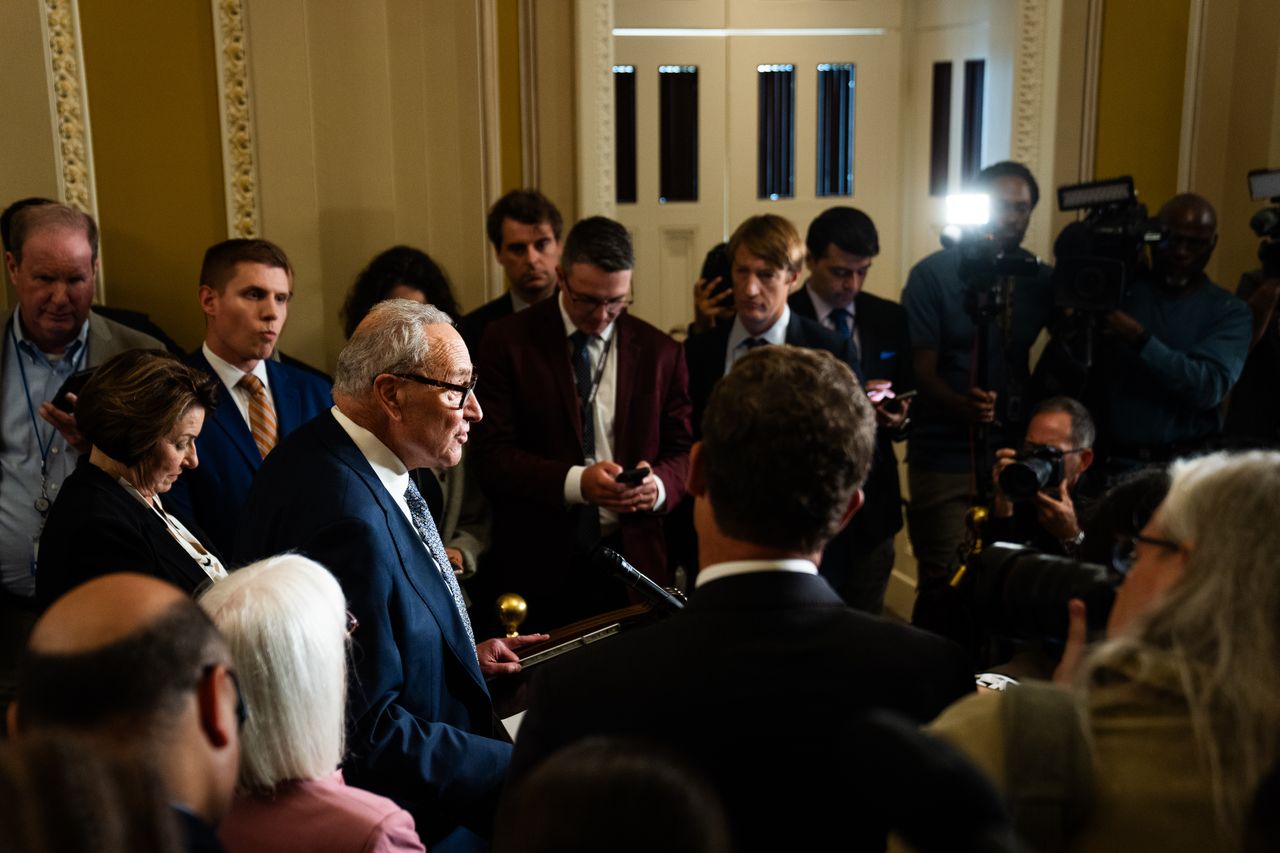| |  | | | | |  | By Megan R. Wilson | - Health-driven shutdown: A battle over Affordable Care Act premium tax credits led to the government shutdown. Now, Democrats and Republicans will both likely have to bend to get out of it.
- Art of the deal: Pfizer’s drug pricing deal with the Trump administration could have been much worse for other big players in the industry.
- Abortion access: A federal case that, if successful, could limit access to medication abortion could be moving to a new venue.
Good afternoon and welcome to the Health Brief newsletter. I’m Megan Wilson, and I’m your host. I’m on the hunt for all intel on government funding negotiations, drug pricing deals and everything that’s flying under the radar. Do you have any tips, scoops or intel? Let’s chat. You can reach me at megan.wilson@washpost.com or on Signal at megan.434. This newsletter is published by WP Intelligence, The Washington Post’s subscription service for professionals that provides business, policy and thought leaders with actionable insights. WP Intelligence operates independently from the Washington Post newsroom. Learn more about WP Intelligence. |  | | Senate Minority Leader Charles E. Schumer (D-New York) on Capitol Hill before the government shutdown. (Demetrius Freeman/The Washington Post) | | | |  | The Lead Brief | The federal government has officially shut down, and health care at the center of it all. I’m thinking of this Raymond James investor note on what ends shutdowns: “When political pressure mounts sufficiently on one or both parties, often triggered by operational crises.” What will be the thing that breaks the logjam now? As the analysts point out, the longest government funding lapse in history occurred during the first Trump administration and ultimately came to a resolution after concerns about military pay. → Read this report from The Washington Post’s Kevin Schaul and Kevin Uhrmacher on the shortest and longest government shutdowns in U.S. history. With a flood of reports about how much health insurance premiums are set to skyrocket for those receiving Obamacare tax credits (by an average of roughly 114 percent, according to a new KFF analysis) without an extension, could health cost fears trigger the impetus for a deal this time around? “Republicans are trying to stay united behind a clean [continuing resolution] for now, but President Trump loves negotiating,” wrote the analysts at Raymond James on Tuesday night. | | | |  | Industry Rx | The vibe check on drug pricing among members of the pharmaceutical industry is mixed, but most of the big players are breathing a sigh of relief over the deal Pfizer cut with the Trump administration. I’ve been talking with more than a dozen industry executives, analysts and lobbyists over the last day. Overall, there’s a sentiment among large companies that the deal could have been much worse. If there were any doubt: Pfizer and other big drugmakers, such as Eli Lilly, have seen their stock value climbing since the announcement. President Donald Trump on Tuesday mentioned Lilly is likely next to cut a drug-pricing agreement — with more to follow after that. Some companies were apparently caught off guard by the announcement, and midsize drugmakers are now worried about how the impending deals could trickle down to them. But the administration had made it very clear it would bring the full force of the federal government against companies that didn’t come to the table, so some kind of deal had been expected. I’m planning to delve into the impacts on other areas of the health industry throughout the week. For now, let’s go through what Pfizer’s announcement means: - There are no real limits on how much Pfizer can charge for the new drugs it brings to market: The company agreed to launch new products at the same prices it offers to other wealthy countries — called the “most favored nation,” or MFN, price — but it could simply delay a launch in European countries, for example, so there’s not another price tag with which to compare it.
- The effort to sell medicines directly to patients at MFN prices is unlikely to solve the affordability problem: In Tuesday’s Oval Office briefing with Pfizer to announce the deal, the administration touted massive discounts on the company’s products, up to 80 percent off, directly to patients. But the platforms — pioneered by companies seeking to cash in on the demand for GLP-1 weight loss drugs — are generally beneficial only to patients willing and able to pay cash, and the medicines can still be prohibitively expensive.
Patients will be able to buy one of Pfizer’s migraine drugs, the White House gave as an example, at half off — but that price tag could still be about $600 per month if the discount applies to the retail price. Another one of Pfizer’s drugs the administration touted, Xeljanz, is going off patent next year — meaning cheaper generic copies of the rheumatoid arthritis drug are soon to follow. - The company is able to stave off national security tariffs for three years by promising to reinvest international earnings into the U.S. market: The reinvestment pledge is “not likely materially impactful,” Chris Meekins, a former Department of Health and Human Services official, wrote on Tuesday. A pharmaceutical industry advocate said the same, noting that the company isn’t losing money, it’s only being shuffled around.
- Promising most-favored-nation pricing in Medicaid could decrease government spending, but patients likely won’t see a benefit: The program already extracts large discounts from drugmakers on medicines. A KFF analysis last year found that drugmakers already sell drugs to Medicaid at more than half-off, depending on the product.
It’s not yet clear how much the federal government will save, but Medicaid beneficiaries already pay little to nothing out of pocket for their medicines, Liz Williams, a senior policy manager with KFF’s Program on Medicaid and the Uninsured, tells me. Medicaid makes up a paltry amount (less than 5 percent) of Pfizer’s overall U.S. revenue. Drugmakers specializing in rare disease drugs — which are more expensive, requiring larger discounts — could face a more consequential hit from MFN demands. | | | |  | Litigation Report | A lawsuit that could determine the fate of medication abortion is heating up, with a federal judge in Texas filing to move the case to a Missouri court. Republican attorneys general in Missouri and two other states have sued the Food and Drug Administration, claiming the agency exceeded its authority in regulating abortion drug mifepristone. → If the lawsuit is successful, it could limit access to mifepristone nationwide — a key prescription medication used to terminate a pregnancy. Medication abortions represent more than 60 percent of abortions in the U.S. health system, according to the Guttmacher Institute. The effort to move the case to a Missouri federal court came after the Justice Department argued in May that the states — Missouri, Idaho and Kansas — didn’t have standing to sue in Texas. The filing: Matthew Kacsmaryk, a federal judge in the U.S. District Court for the Northern District of Texas filed paperwork on Tuesday to relocate the suit to the Eastern District of Missouri, arguing it is “in the interest of justice” to do so. The move serves to “‘prevent waste of time, energy and money’ to transfer rather than dismiss … instead of returning this years-long case to square one.” → Katie Keith, director of the Center for Health Policy and the Law at Georgetown Law, called it the “most significant legal development we’ve seen” since the Supreme Court’s decision in a June 2024 medical abortion case. That decision ruled that the Alliance for Hippocratic Medicine and other antiabortion plaintiffs, who sued in 2022, didn’t have the standing to bring the suit. “While Judge Kacsmaryk could have simply dismissed this lawsuit,” Keith added, “the transfer means the litigation — and the threat it poses to nationwide abortion access — will continue.” What’s next: There is a 21-day pause on the case before it moves to the new venue, which allows time for an appeal. → Last week Health and Human Services Secretary Robert F. Kennedy Jr. said that he’s reviewing whether mifepristone is safe. The FDA approved the drug in 2000, and advocates maintain its safety has been backed by science. | | | | | | | | | | |